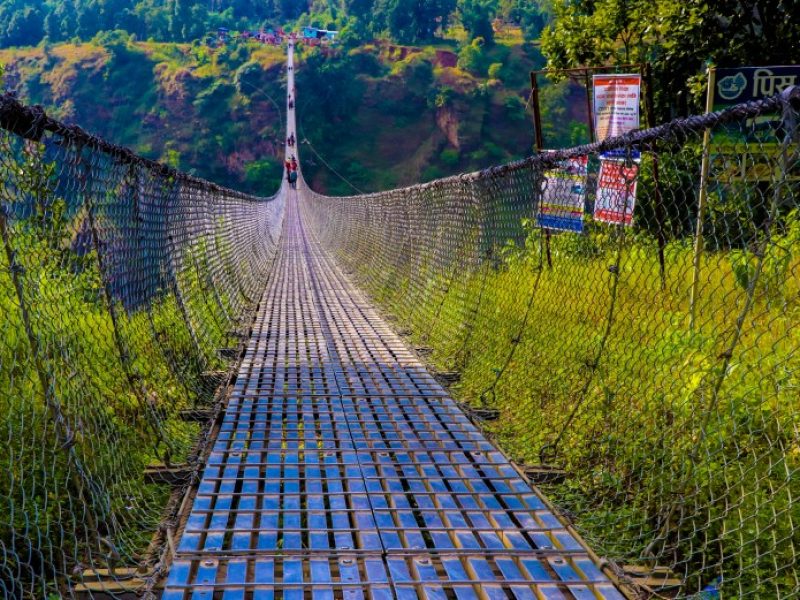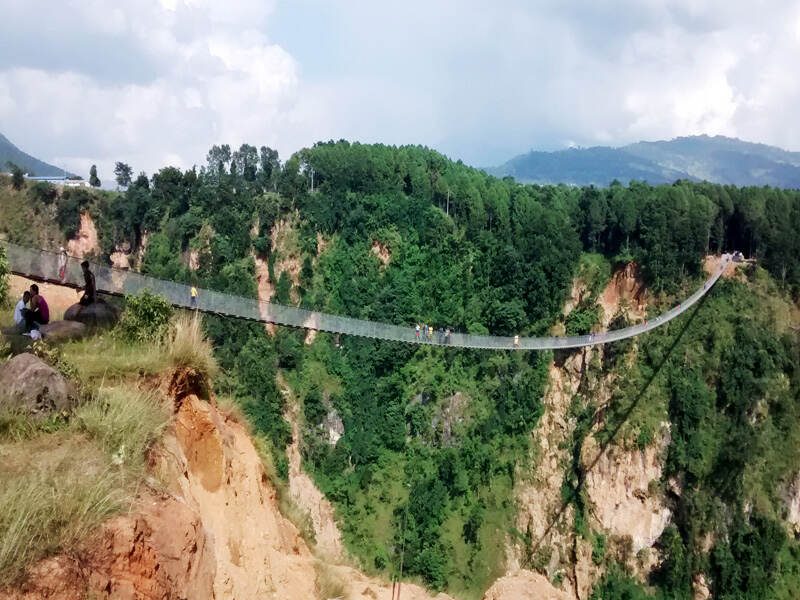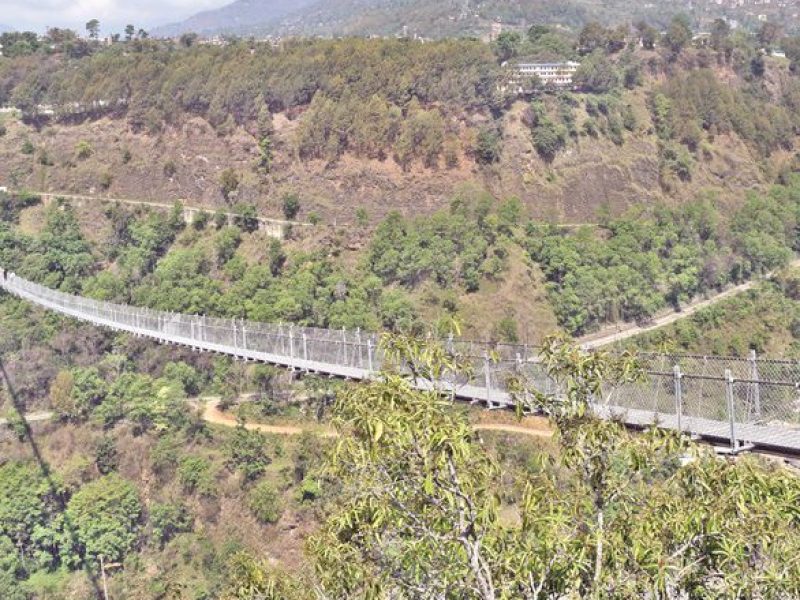Baglung Bridge is the world’s second longest bridge. It is also known as the Gandaki Golden Bridge and is a 567m suspended footbridge. It has a capacity of 85MT and the ability to carry 612 people at a time. This bridge connects Kusma Municipality to Baglung.
The Gandaki Golden Baglung Bridge in Nepal shows how technology and architecture can be amazing. It connects communities and facilitates trade and travel. The bridge looks strong and pretty with its curved shape and shiny golden color making people feel like things are moving forward and connected. Tourists are drawn to the Gandaki Golden Bridge not only for its structural magnificence but also for the breathtaking views it offers.
The bridge helps people and transportations move around better by giving them a safe way to cross. The bridge shows how smart people working together can overcome hard things like when engineers and workers built it by working really hard. As a symbol of progress and unity, it promotes economic growth and closeness between people from diverse backgrounds.
Historical Background Of The Baglung Bridge
In 2059 BS the study of Baglung Bridge was done. The construction of the bridge began in Chaitra, 2075 BS. In Asar 2077 BS was the scheduled year to complete the construction of the bridge. The COVID-19 pandemic delayed the completion of Baglung Bridge in July 2020, despite the project team finishing it three months ahead of schedule.
The construction of the Gandaki Golden Bridge addressed the limited connectivity between communities by spanning over the river, thereby enhancing Nepal’s socio-economic landscape, trade, travel, and social interactions.
They successfully completed the project despite facing challenges like natural obstacles and the powerful currents of the Gandaki River. Engineers made sure the bridge could stay strong and safe from natural disasters like earthquakes and floods by using smart design methods.
The bridge gives people hope and chances for better lives by helping businesses to grow, bringing people together and joining villages nearby. Funding for the project was secured through government allocations, international aid and private investments.
Structural Features Of Gandaki Golden Bridge
The Gandaki Golden Suspension Bridge is strong and useful with really tall towers, strong cables and hanging cables. High-strength steel makes the main cables, supporting the deck, while the towers provide a solid foundation for the bridge.
Vertical suspender cables evenly distribute the weight of the deck and reduce stress. The bridge deck, made of reinforced concrete or steel, provides a stable surface and hangs from hangers. The bridge’s design ensures safe and reliable passage for travelers. With each step across its region, it is surrounded by the spirit of the Himalayas, attracting people to start on a journey of discovery and enlightenment.
Construction Challenges Of The Baglung Bridge

Construction of the Baglung Bridge was tough because the structure of the land is often rough, weather and environment. Engineers used helicopters and specialized vehicles to transport materials and equipment, overcoming obstacles. Deep foundation techniques were employed in order to anchor suspension towers securely.
Smart people finished constructing the bridge despite the threat of weather conditions like monsoon rains and high winds, building temporary shelters to protect workers and equipment and implementing strict safety protocols to ensure crew well-being. The completion of the bridge made life easier for the communities nearby.
Significance Of The Gandaki Golden Bridge
The Gandaki Golden Bridge connects communities separated by the Gandaki River, facilitating easier transportation, fostering business growth, and uniting people. It helps people move around easily and makes it easier to buy and sell goods. The Baglung bridge represents hope and opportunity for the people living around the bridge.
The bridge also holds cultural and social importance, symbolizing progress and modernization and improving access to important services like healthcare and education. During natural disasters it serves as a lifeline by providing uninterrupted access for emergency response teams and relief efforts.
How The Gandaki Golden Bridge Transforms Communities?
The Gandaki Golden Bridge is a vital transportation link that improves connectivity and accessibility across the Gandaki River. It reduces travel times and facilitates seamless movement between isolated regions improving access to essential services like healthcare, education and employment.

The bridge also stimulates economic growth by facilitating the flow of goods, services and capital across the region. Overall, the Baglung Bridge represents the collective aspirations and resilience of its communities.
It also plays a vital role in regional integration and social cohesion, promoting cultural exchange and mutual understanding among diverse populations. In emergencies, the bridge provides a lifeline for relief supplies, rescue teams and medical personnel, ensuring community safety and well-being.
Economic Impact Of The Baglung Bridge
The Baglung Bridge has significantly impacted the economic development of the surrounding region. The communities on either side of the Gandaki River have improved access to markets and resources facilitating trade and commerce.
The bridge has also encouraged economic activity by creating new opportunities for investment and entrepreneurship, attracting new industries and jobs. The scenic beauty of the region has attracted tourists, creating demand for hospitality services and restaurants.
The construction of the bridge has led to infrastructure development, improving connectivity and access to essential services, thereby promoting trade, attracting investment and tourism.
Tourism Potential By The Construction Of The Gandaki Golden Bridge
The Gandaki Golden Bridge is located in Gandaki Province which has increased tourism by attracting visitors to explore the region’s natural beauty and cultural heritage. The bridge’s strategic location has made it a popular tourist attraction, offering stunning views of the Gandaki River valley and facilitating access to hiking trails and trekking routes.
It has also promoted cultural tourism by making it easier to explore historical sites and local traditions. The bridge has also led to the development of supporting infrastructure, such as hotels, guesthouses, restaurants and souvenir shops, creating employment opportunities and generating income for local residents.
As tourism continues to grow, the bridge will play a crucial role in driving economic growth and sustainable development.
How The Baglung Bridge Cares For The Environment?
The Gandaki Golden Bridge project prioritized environmental considerations to minimize ecological impact and promote sustainable development. Before construction began, we conducted assessments to identify sensitive areas and species, and we implemented measures to minimize disturbance.

Best management practices such as sediment traps, silt fences, and vegetative buffers preserved water quality in the Gandaki River and its tributaries. Noise and air pollution were mitigated through the use of noise-reducing devices and dust control measures.
Throughout the project, we prioritized sustainable materials and construction practices, utilizing recycling and energy-efficient construction methods. We maintained environmental monitoring and compliance to ensure our actions aligned with sustainability goals. The project serves as a model for future infrastructure projects.
Maintenance And Upkeep Of The Gandaki Golden Bridge
The Gandaki Golden Bridge is a vital transportation link and symbol of progress for generations. Its maintenance and upkeep are crucial for its safety, functionality and stability. Regular inspections are conducted by trained engineers to assess the bridge’s structural integrity.
Regular maintenance tasks include cleaning and painting structural components, lubricating moving parts, and replacing damaged elements. Vegetation control measures are also implemented to prevent plant growth.
Maintenance personnel use specialized equipment and machinery, while strictly following safety protocols. They develop emergency response plans to address unforeseen events and install continuous monitoring and surveillance systems to detect potential issues.
The Unique Beauty Of The Gandaki Golden Baglung Bridge
The Gandaki Golden Bridge stands out for its unique design, construction, and significance. Unlike suspension bridges like the Golden Gate Bridge and Akashi Kaikyo Bridge, it features graceful arches and a golden hue. Despite its rugged terrain, the bridge incorporates suspension elements for added flexibility and resilience.
Unlike cable-stayed bridges like the Millau Viaduct or Russky Bridge, the Gandaki Golden Bridge’s traditional suspension design stands out for its timeless elegance and cultural significance. Despite its similarities, the Baglung Bridge stands as a symbol of human ingenuity and connectivity in the region.
Conclusion
In conclusion, The Gandaki Golden Bridge is a symbol of human equality, engineering excellence, and progress. It serves as a vital link between communities, facilitating economic development and promoting social cohesion. It represents hope, opportunity, and progress, inspiring future generations and leaving a lasting legacy.
The spirit of the Himalayas surrounds travelers with each step across its region, enticing them to embark on a journey of discovery and enlightenment. The Baglung Bridge not only connects distant shores but also bridges the gap between man and nature, leaving an indelible mark on all who tread upon its golden path.
Frequently Asked Questions (FAQS)
1. What is the Gandaki Golden Bridge?
The Gandaki Golden Bridge is a prominent bridge spanning the Gandaki River in Nepal’s Gandaki Province. It serves as a vital transportation link, connecting communities on either side of the river.
2. Why is it called the “Golden” Bridge?
The bridge earns its moniker, the “Golden” Bridge, thanks to special coatings or paint applied to its structural elements, giving it a distinctive golden hue.
3. What are the main features of the Gandaki Golden Bridge?
The main features of the Gandaki Golden Bridge include its sturdy construction, graceful arches, and towering suspension towers. High-strength cables support it, featuring a deck for vehicles and pedestrians to cross.
4. What was the purpose behind constructing the Gandaki Golden Bridge?
The primary purpose of constructing the Gandaki Golden Bridge was to improve connectivity and facilitate transportation between communities on opposite sides of the Gandaki River. It also aimed to promote economic development and social cohesion in the region.
5. How was the Gandaki Golden Bridge constructed?
Advanced engineering techniques and materials constructed the Gandaki Golden Bridge. Skilled laborers and engineers worked together to erect the bridge’s structural components, including the suspension towers, cables, and deck.
6. What are the benefits of the Gandaki Golden Bridge?
The Gandaki Golden Bridge provides numerous benefits, including improved access to markets, enhanced connectivity, and increased opportunities for economic development. It also promotes tourism and facilitates the movement of goods and people across the region.
Introducing Trek Me Nepal: Embark on Unforgettable Journeys
At Trek Me Nepal, every step you take should be an adventure, every breath you inhale should be filled with the essence of nature, and every heartbeat should resonate with the rhythm of the mountains. We are a passionate team of explorers committed to crafting unforgettable trekking experiences in the breathtaking landscapes of Nepal.

Comment (0)